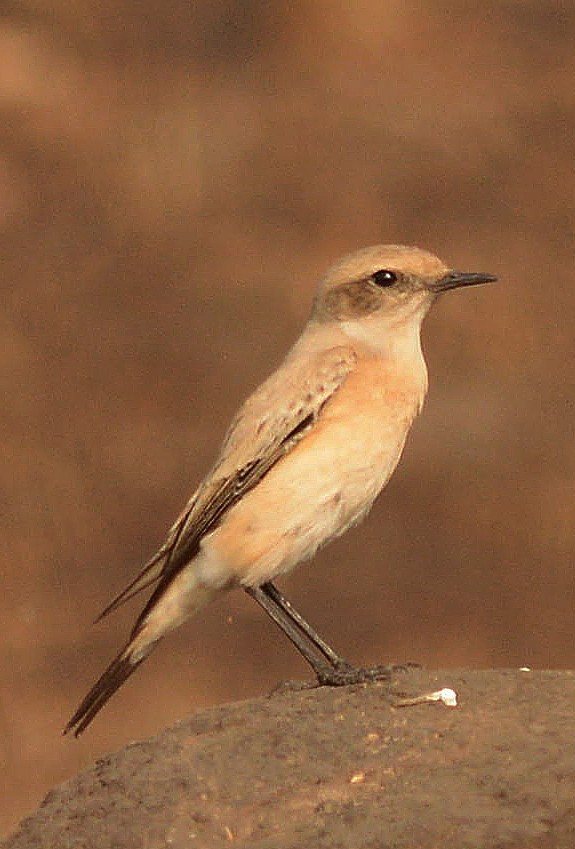Desert Wheatear
A species of Wheatears Scientific name : Oenanthe deserti Genus : Wheatears
Desert Wheatear, A species of Wheatears
Botanical name: Oenanthe deserti
Genus: Wheatears
Content
Description General Info
 Photo By Dr. Raju Kasambe , used under CC-BY-SA-4.0 /Cropped and compressed from original
Photo By Dr. Raju Kasambe , used under CC-BY-SA-4.0 /Cropped and compressed from original Description
The head and nape of the adult male desert wheatear are a pale sandy-grey colour with the feathers tipped grey. The mantle, scapulars and back are a similar but rather richer colour. The rump and upper tail-coverts are pale buff. The basal third of the tail feathers are white and the rest black with a pale buff tip. A curved stripe over the eye is pale buff and extends backwards. The feathers of the chin, throat, lores and ear-coverts are black tipped with white. The breast and flanks are sandy-buff and the belly and under tail-coverts are creamy-white tinged with buff. The axillaries and under wing-coverts are black tipped with white. The primaries have black outer webs, tipped and edged with white and inner webs pale brown edged with white. The secondaries are similar but have broader white edges to both webs. Its length is about 15 centimetres (5.9 in) and it weighs between 15 and 34 grams (0.53 and 1.20 oz). The female has similar plumage but the rump and upper tail-coverts are more sandy brown, the lores, chin and throat pale buff and the dark parts of the tail brownish-black. The juvenile is similar to the adult female but the feathers on the upper parts of the body have pale centres and brown tips which gives the bird a more speckled appearance. There is a single annual moult in late summer and by the following spring the feathers have become rather abraded, with the white tips tending to be worn away, leaving the bird with rather richer colouring. The beak, legs and feet are black and the irises of the eyes dark brown. 
Size
15 cm
Colors
Brown
Black
Yellow
Gray
White
Nest Placement
Ground
Feeding Habits
Desert Wheatear primarily consumes insects like ants, beetles, caterpillars, and flies, including larvae. The bird forages by darting from perches to the ground, and can hover and catch prey mid-air. Its diet also includes seeds, indicating omnivorous habits. Desert Wheatear is known to display wing-fluttering behavior before large insects.
Habitat
Desert Wheatear's habitat is characterized by extreme environments such as deserts, semi-arid plains, and rocky expanses with minimal vegetation. Preferring open and flat terrains up to 3,500 meters in elevation, desert Wheatear can be found in dry riverbeds, wadis, and saltpans. During winter, they may occupy cultivated lands that provide sufficient bare ground for nesting.
Dite type
Insectivorous
General Info
Feeding Habits
Bird food type
Sounds
Call
Recording location: China
Song
Recording location: India
Behavior
The desert wheatear tends to perch on a bush, tussock or grass or other eminence and dart to the ground beneath to pounce on insects and other small invertebrates, though it can also catch insects in the air. The diet usually consists of ants, beetles, caterpillars and flies and the larvae of various insects including ant-lions. In addition to these, seeds have also been found in its stomach. It is able to hover for short periods and when it finds a large prey insect, with which it is unable to cope, it sometimes displays in front of it by fluttering its wings. The desert wheatear breeds during late April or May over most of its range. It nests on rocky hillsides, on steppes, on sandy plains, in crevices in walls or in hollows under rocks. The nest is often concealed behind gorse (Ulex europaeus) bushes or other bushy vegetation and is a tidily-built cup made of grasses, mosses and stems, lined with fine roots and hairs, and sometimes small feathers. A clutch of four (occasionally five) eggs are laid. These are pale bluish with fine rusty speckles, usually forming a distinct zone at the wider end. They measure approximately 20.1 by 15 millimetres (0.79 in × 0.59 in). Incubation is done mainly by the female and both sexes help care for the young. 
Distribution Area
The eastern race of the desert wheatear breeds in a great swathe of Asia extending from the Middle East and Saudi Arabia through Iran, Baluchistan, Afghanistan, the south Caucasus, Turkestan, the Tarbagatai Mountains, the Altai Mountains and north western Mongolia. Birds from this region migrate southwards to overwinter in northeastern Africa, the Arabian peninsula, Iraq and Pakistan. The western race breeds in North Africa from Morocco and Rio de Oro to the part of Egypt west of the River Nile. This population is largely resident but in Morocco, birds in the south and east part migrate while those in the south west tend not to. The habitat of the desert wheatear is barren open countryside, steppes, deserts, semi-arid plains, saltpans, dried up river beds and sandy, stony and rocky wasteland. It is found at altitudes of up to 3,500 metres (11,500 ft). During the winter it may also visit cultivated land when this is interspersed with bare areas of countryside. The desert wheatear is an occasional vagrant to the Ireland and Britain, and a female got blown off course in October 2012 during its autumn migration and was seen in a sandpit in Essex. Only a few weeks later, another was seen in the RSPB Loch of Strathbeg reserve in Scotland. 
Species Status
Not globally threatened.
Scientific Classification
Phylum
Chordates Class
Birds Order
Perching birds Family
Old world flycatchers Genus
Wheatears Species
Desert Wheatear